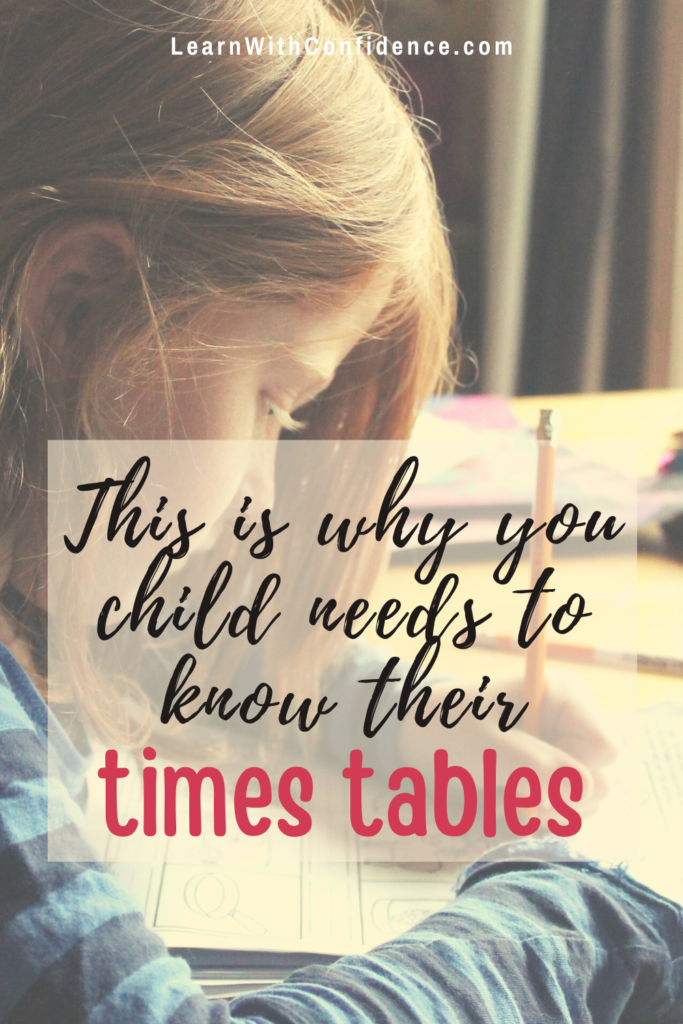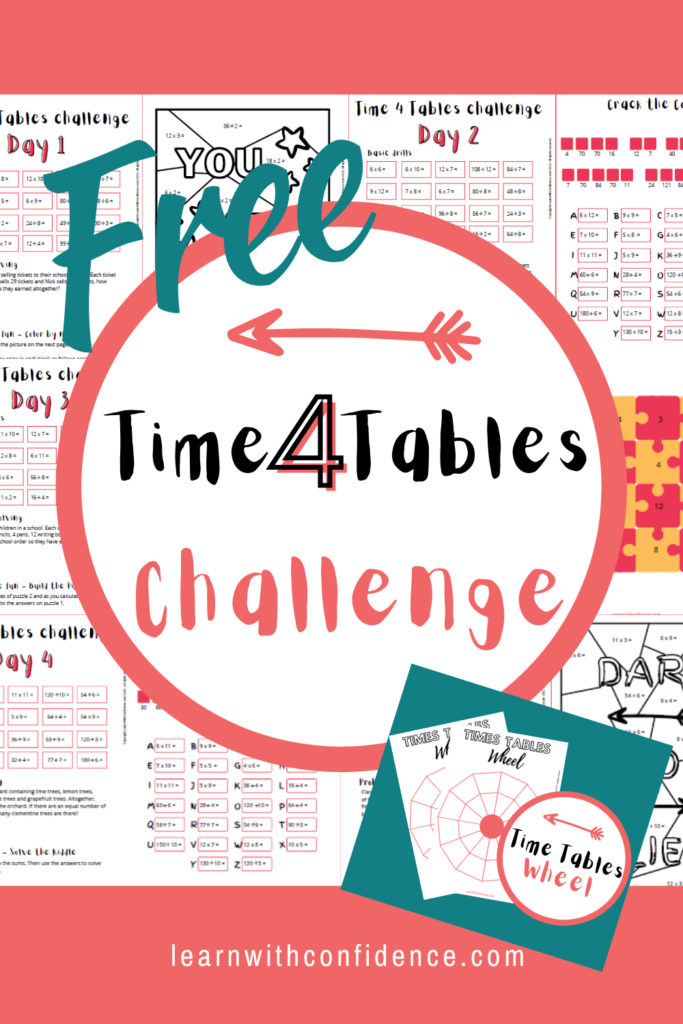12 Strategies for learning Times Tables off by heart.

Learning times tables off-by-heart has long been a skill that teachers have advocated for. But is it really that important a skill to have? Is there a way to make learning times tables fun and effective?
My mom used to help me with homework and studying when we were kids. But honestly, I don’t have many actual memories of that. I do have one vivid memory though. It was Grade 4. I sat on the bed across from my mom and we learnt my times tables together. We reciting them over and over, she tested me over and over, until I knew them off-by-heart.
I can’t tell you how grateful I am that she spent that time with me and made me learn those tables! Because it set me up for success in Math.
You can make all the difference to your child’s success in Math too, and here’s how making times tables a priority can do that.
This post may contain affiliate links. If you use these links to buy something I may earn a commission, at no extra cost to you. Thank you for supporting me!
Times tables are in every part of Math
The biggest reason times tables are actually really important is that they are used in EVERY topic within Math.
Here are a few examples:
- Sums and word problems that use multiplication, division, adding and subtracting
- Patterns (5, 10, 15, 20 – these are multiples of 5)
- Fractions (4/5 of 50 apples = 50 / 5 x 4)
- Measurement (4 sides of the fence that are all 15 metres long = 15 x 4)
- Ratio (1:3 of 99 people = 99 / 3)
- Percentages (15% of 20 = 15 / 100 x 20)
- 2D and 3D shapes (relationship between the number of faces and the number of edges or vertices)
- and so many more.
Truth is, you probably won’t even realize you’re using your knowledge of times tables because you do it automatically in your mind. The only time you’re completely aware of using them is when you don’t know them that well!

Benefits of knowing your times tables off by heart
I’m a big fan of learning times tables off-by-heart! Like, it’s one of those things you JUST. HAVE. TO. KNOW!
And Math teachers around the world will agree with me that knowing times tables off-by-heart is a vital skill. There are a number of benefits to being able to work out what 7 x 8 is quickly in your head. (It’s 56, if you weren’t sure!)
I’ve seen how the kiddos who know them and can use them benefit and how those who don’t really struggle. And here’s why:
It’s a foundational concept.
With so many Math topics and concepts relying on times tables, it’s safe to say that it’s a very foundational concept or skill.
If your child knows them, can remember them and use them effectively, your child is going to find learning the other Math concepts a lot easier! If that foundational building block is in place and secure and everything else built on or around it will be firmly established too.
The converse is that without the ‘times table building block’, your child will have a learning gap that can impact their success and confidence in Math.
It will improve your child’s speed.
Knowing times tables off-by-heart seems like a really old concept – like, we don’t do rote-learning anymore, thank you very much!
But here’s the thing…
The more you can do automatically, the less mental energy and time you’ll spend on it. (This is why we have routines – when you wake up, you do certain things to get yourself ready. You don’t have to think about them at all or make any decisions. Imagine if you had to decide on how you were going to brush your teeth every morning!)
If your child still has to count on their fingers or draw a picture or write out a list to work out what 6 x 7 is, they are wasting precious time and mental energy.
If they can look at those two numbers multiplied together and immediately write down an answer, without hesitation, they will finish their tests, they will get through their homework, they will feel like a super-star!
It will improve your child’s accuracy.
When it comes to times tables, having improved speed doesn’t have to mean a compromise on accuracy.
In fact, if your child knows their times tables off-by-heart, they will likely answer their math problems more accurately!
Why is that?
Because, they’re not going to get distracted by trying to work them out! Math sums often have many steps and components. If your child knows their times tables they’ll be able to focus on what the question was really asking them to calculate.
And, then because they can work out the components accurately, their answers will be correct!
Here’s something to kickstart their success with times tables. 5 days of worksheets and fun activities to hone their times tables skills.
Strategies for teaching your child their times tables
So if this is such a crucial skill, how can I make sure my child knows these times tables off-by-heart?
Before we talk strategy, let me say this:
Your child has to learn them AND practice them to be able to use them in an automatic way. So whatever strategy is going to work best, your child needs to use it regularly until those times tables can just flow out of their mouth without them even thinking about it!
Each child has their own learning style.
You know your child best! And you can probably already tell that your child is more of a visual, auditory or kinesthetic learner. Learning according to their learning style, will mean they can “put info in”, store it and use that info more effectively.
Here are two tools you can use to test your child’s learning style. The first tool is a quick 20 questions you can do online. And the second tool is a pdf with a more in-depth look at how your child learns best.

Strategies for the visual learner
Visual learners must SEE to be able to learn and understand their work.
These are some ways you can help your visual child learn their times tables off-by-heart:
- List or table
- Multiplication flowers or wheels
- Flash cards
- Practice worksheets
- Practice tests or drills
Strategies for the auditory learner
If your child is an auditory learner, they need to hear or speak to be able to learn effectively.
These are some ways you can learn times tables with your auditory child:
- Recite them out loud according to a rhythm or beat.
- Use a times tables song.
- Recite them while clapping hands or tapping on the table or playing an instrument.
Strategies for the kinesthetic learner
The kinesthetic learner is someone who needs to move while they’re learning. These strategies are effective for younger children too because young children are very concrete and they need to use their bodies to learn.
So here are the activities you can do with your kinesthetic child:
- Recite times tables while your child jumps on the trampoline, kicks a ball against the wall or throws it back and forth with you (or against the wall).
- Get your child on their feet, writing them out (using a visual technique) on a big whiteboard or on a mirror or window.
- Dance or do exercises while singing along to a times tables song.
- Do a flash card ‘treasure hunt’ where they search the house or garden to find and solve the flash cards.
Some general pointers
Helping your child learn their times tables can be a fun bit of bonding time, and even create happy memories! Here are some tips for making the most of it.
Make it fun
Kids will learn ANYTHING…will do ANYTHING (even chores!), if they think it’s fun!
Some kids will think writing a list of their times tables in multiple colors is the most fun ever! For another child, jumping on the trampoline or kicking a ball around is what makes them happy.
Find their currency. Figure out what they find fun and then use that to make this task fun.
Be positive
If you tell your child you hated Math, or learning times tables; or you flop down to do this with them with an attitude of “urgh, this sucks!” Your child is going to have that attitude towards Math too.
If you are positive, they’re more likely to be positive.

Practice every day
When it comes to Math, it’s like learning a language. The more you use it, the more proficient you become!
I would advise that your child should practice their times tables or part of them EVERY DAY! Use different techniques and activities, just pick a few times tables for each day, and then, get it done!
This Homework Planner has a section for tracking which times tables your child has practiced for each day of the week – it’s a great way to make sure they’re doing it every day and they will start to see results the more they practice.
The results will come
As with anything, it’ll take time to see results. But the time and energy your child invests in learning their times tables off-by-heart, the more they will see those benefits and results.
Need something quick and easy (and free!) to get you started?
Remember to download your FREE 5-day times tables challenge. This will kickstart your child’s times table learning journey and give you a resource that’ll equip you to help them more effectively!

I would love to connect with you and hear all about your parenting adventures! And I’d love to include you in this community of Mommies as we support each other and grow together to become the best moms we can be!
Please subscribe to my emailing list here and I’ll make sure I keep you in the loop on all the latest blog posts, freebies and resources!







